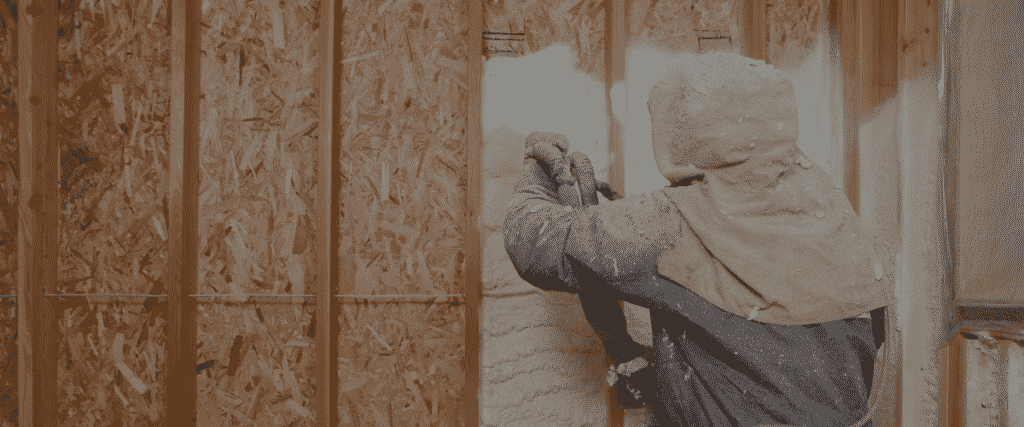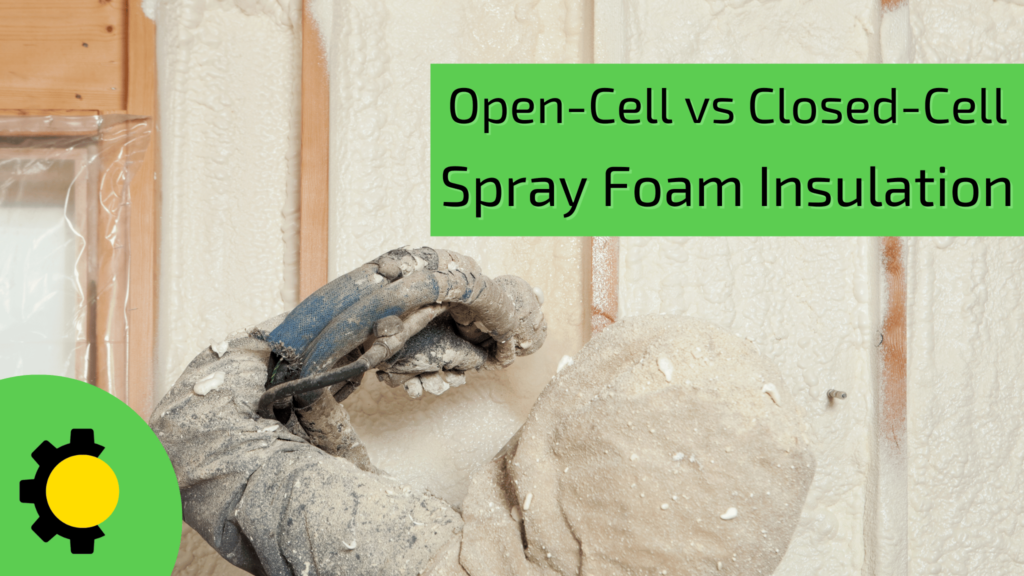In the world of spray foam insulation, there are two types to consider: open-cell and closed-cell. Not only does spray foam help block heat flow, but it also blocks airflow in general. This makes your home more comfortable and reduces your energy costs. Because of this, there are very few instances when spray foam shouldn’t be used.
While both offer considerable benefits, it’s important to know which will work best for your application. Here, we’ll analyze closed-cell vs. open-cell foam to help you make a wise and informed choice.
What is spray foam insulation?
Let’s begin by explaining what spray foam insulation is. Unlike fiberglass and mineral wool, spray foam insulation is completely chemical-based. Coming in powder form, it’s mixed onsite and then applied with a sprayer to the desired location.
Spray foam is used to insulate ceiling cavities, walls, and floors. Foam insulation is a great choice for insulation in your home because of its unique structure. It doesn’t shrink, sag or settle over time. Spray foam, both open-cell and closed-cell, can last extremely long.
The benefits of spray foam insulation
Spray foam insulation is not only energy-saving; its application is relatively easy, even in challenging areas. And it can offer some pretty significant cost savings.
It can be utilized in both residential and commercial buildings, agricultural facilities, and in wood or steel framed structures. It can even be used to insulate storage tanks.
The versatility of spray foam insulation makes it appreciated by both property owners and construction professionals because of its efficiency. It doesn’t sag or settle over time like fiberglass insulation can if not correctly installed. Spray foam insulation adds structure and sturdiness to buildings. Spray foam insulation’s ability to expand into every crack and crevice prevents entry by rodents and insects. It lasts longer than alternatives, so it uses up less materials, resulting in a reduced carbon footprint.

What’s the difference between closed-cell and open-cell spray foam insulation?
Each type of spray foam insulation has its own pros and cons. It all comes down to choosing the right type for you and your needs.
Let’s examine the differences between open-cell vs closed-cell foam insulation.
Closed-cell foam vs Open-cell Composition
The benefits of open-cell foam insulation are that it’s light, flexible, and easy to use. Closed-cell foam insulation, however, is very rigid and dense, though this too is a good thing.
Because of its flexibility, open-cell makes it easier to accomplish tasks like installing new wiring after it’s in place. To get the foam where you want it, all you have to do is to use fish tape.
With closed-cell, jobs like wiring aren’t possible after installation, but the foam’s durability is excellent. Because of its rigid structure and durability, closed-cell is ideal for exposed walls. It’s less likely to get damaged by machinery or tools.
Open-cell vs Closed-cell Density
Closed-cell foam has a higher density than open-cell insulations. Open-cell foam averages about .5 lbs per cubic foot. Closed-cell foam may have a density over three times higher, at 1.75 pounds per square foot.
Open-cell vs Closed-cell Sound Dampening Qualities
Before we dive into which one is best for it, we’ll explain what sound dampening is.
Soundproofing and sound dampening are two different things. A room that is soundproof means it’s impervious to sound. Sound dampening is a way to reduce sound transmission.
Open-cell foam is porous and more flexible, which allows it to absorb and reduce sound waves better than closed-cells.

Open-cell vs closed-cell Moisture Permeability
When it comes to preventing moisture, one spray foam allows water to pass through, while the other blocks it completely.
Open-cell foam is naturally moisture permeable. This means that water can flow through it. There are variations in the ability to absorb free-standing water depending on which spray foam brand you choose.
A good spray foam might only retain 5 percent of its weight in water. Open-cell spray foam brands may retain up to 75% of their weight in water.
Closed-cell spray foam is, however, 100% moisture impermeable. This means that water can’t move through it. Although the moisture impermeable option sounds better, open-cell spray foam can still be useful on roof decks in attics.
Open-cell foam will discolor if there is a leak. This’ll let you know where it is and allow you to repair it quickly. However, closed-cell spray foam can conceal the leak until it builds up elsewhere, causing much greater problems and headaches.
Open-cell vs Closed-cell Air Seal
Both open and closed-cells provide a seal to prevent air leaks, heat loss, and moisture from entering your home.
An air seal is only possible with a thickness of 2 inches for closed-cell and 3 inches for open-cell. These are the minimums, and the recommended thickness will vary depending on the application and the purpose of the spray foam.
Open-cell should be 6-10 inches on the roof deck or ceiling, depending on climate, and 3 inches in the walls. Closed-cell foam insulation shouldn’t exceed 4 to 5 inches above the ceiling, and 2 to 3 inches within walls. These amounts are sufficient to provide the best value for money with the thermal resistance and air seal required.
Many people believe that more foam means a higher R-Value. However, this isn’t the case past the recommended amounts. The most important thing is an air seal. Once you’ve reached the amount of foam required to make an air seal, it’s not worth adding more.
Open-cell vs Closed-cell R-Value
Spray foam insulation’s R-Value can vary depending upon the product and manufacturer.
The R-Value of open-cell foam is usually in the range R-3.6 to R-3.9 per inch. R-6 to R-7 is the common range for closed-cell foam R-Value.
Spray foam R-Value is affected by many factors, including its type, age, and resistance to moisture.
Open-cell vs Closed-cell Spray Foam Cost
Spray foam insulation cost will vary depending on the area being insulated, job difficulty, thickness, and type of foam.
Closed-cell foam insulation will always be more expensive than open-cell. There are a few reasons for this, including the cost to produce it, and it being more difficult to apply.
It’s difficult to put an exact number on the cost without a consultation. However, with application costs included, it can cost close to twice as much for closed-cell as open-cell.
Review of Open-cell vs Closed-cell Comparison
Neither open-cell or closed-cell spray foam insulation is superior to the other, overall. The decision of which to choose depends upon the intended use. Here is a summary of features for comparison:
Closed-cell spray foam insulation
- Has a greater R-Value
- Is more rigid
- Offers a more solid vapor, moisture and water barrier
- Is great for crawl spaces
Open-cell spray foam insulation
- Expands more extensively
- Offers a higher level of soundproofing
- Lets water pass, allowing leaks to be located
- More affordable
- Optimal for walls and attics in many areas
Open-cell vs closed-cell spray foam – which to choose?
The good news is you don’t have to use either exclusively for a residence or commercial building. Not only each project, but each area within a structure may require a different choice.
Both open-cell and closed-cell spray foam insulation are great products that offer a wealth of benefits. But they’re made up of chemicals and must be handled with care during application. It’s always best to hire a professional to ensure safe and proper installation.
Sunlight Contractors serves New Orleans and all of Southeastern Louisiana. Our licensed and certified contractors want to assist you in finding which spray foam insulation is best for your project. So, contact us for a free quote. You’ll be glad you did!

